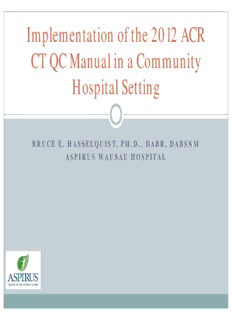
Implementation of the 2012 ACR CT QC Manual in a Community Hospital Setting PDF
Preview Implementation of the 2012 ACR CT QC Manual in a Community Hospital Setting
Implementation of the 2012 ACR CT QC Manual in a Community Hospital Setting BRUCE E. HASSELQUIST, PH.D., DABR, DABSNM ASPIRUS WAUSAU HOSPITAL Conflict of Interest Disclaimer Employee of Aspirus Wausau Hospital ACR Activities Reviewer for CT accreditation program (physics) Reviewer for NM accreditation program (physics) Member Medical Physics Guidelines Committee No conflicts to disclose Objectives Review the major elements of the 2012 ACR QC manual Compare the manual to current ACR accreditation program and phantom testing requirements and to the current technical standard Highlight some interesting details of the new physicist testing recommendations 2012 ACR CT Quality Control Manual Table of Contents Radiologist’s Section Definitions of QA and QC Responsibilities Radiologic Technologist’s Section Daily QC Weekly QC Monthly QC Medical Physicist’s Section Annual QC http://www.acr.org/~/media/ACR%20No%20Index/Documents/Random/2012CTQCManual2.pdf To be accredited by the ACR “Effective 12/01/2013, all facilities applying for accreditation must maintain a documented QC program and must comply with the minimum frequencies of testing outlined in the 2012 ACR Computed Tomography Quality Control Manual.” Page 4: 2012 ACR CT QC Manual What’s Mandatory? Should’s (177 instances!) Must’s (35 instances!) Acceptance testing before 1st Maintain documented QC program patient scanned Comply with minimum testing Equipment evaluation dated frequencies within 1 year at renewal QMP oversees QC program Evaluation after major repairs, QMP monitors performance at incl x-ray tube and detector installation and annually assembly replacement Annual equipment evaluation Refer to state and local submitted initially and at renewal regulations if more restrictive Evaluation dated within 14 months Greater frequently for QC tests at renewal when being introduced or results Evaluation performed by a QMP inconsistent. Annual QMP review of tech QC Records accessible from CT records (qtly preferred) scanner location Quality Assurance is a comprehensive concept to ensure that: 1. Every imaging procedure is necessary and appropriate to the clinical problem at hand; 2. The combination of acquisition parameters used for each exam is appropriate to address the clinical question; 3. The images generated contain information critical to the solution of that problem; 4. The recorded information is correctly interpreted and made available in a timely fashion to the patient’s physician; and 5. The examination results in the lowest possible risk to the patient and is consistent with Objective 2 (above). Quality Control is a series of distinct technical procedures Four steps are involved: 1. Acceptance testing to detect defects in equipment that is newly installed 2. Establishment of baseline equipment performance 3. Detection and diagnosis of changes in equipment performance before they become apparent in images 4. Verification that the causes of deterioration in equipment performance have been corrected (Supervising) Radiologist “Radiologists must assume the primary responsibility for the quality of CT and for the implementation of an effective QA program at their site.” Convene a CT QA or Protocol Review Committee Oversees QA program Sets goals and directions Determines policies Assesses effectiveness of QA activities Assist with development of CT QA Manual Participate in “Interpretive Quality Assurance” aka peer review Quality Assurance Committee • Design and review all new or modified CT protocol settings to ensure that both image quality and radiation dose are appropriate • Develop internal radiation dose thresholds during any new CT protocol design. • Implement steps to ensure patient safety and to reduce future risk if an estimated dose value is above the applicable threshold for any routine clinical exam • Review, at least annually, all protocols to ensure no unintended changes have been applied that may degrade image quality or unreasonably increase dose • Establish a policy stating that the CT dose estimate interface option is not to be disabled and that the dose information is displayed during the exam prescription phase
Description: